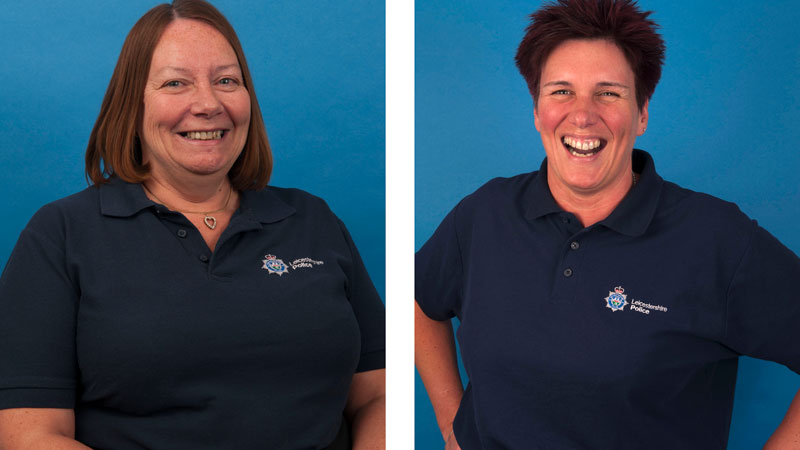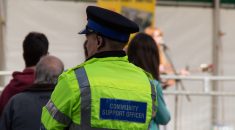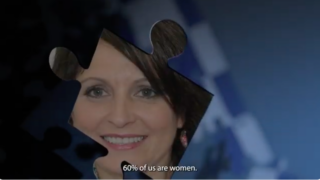You call 999, you’re put through to someone, the police arrive. If you’ve ever had to report a crime, those may be the only stages you’re aware of.
But behind the scenes a whole machine is working to address the situation, keep you safe and investigate. Though police officers are the face of that machine, they’re not the only ones who are part of it. A whole host of police staff – 40% of the entire police workforce, with roles as varied as you can imagine – also play a vital role.
When you call 999 you’re first put through to a BT Operative. If you need the police, you’ll be connected to a police staff contact handler working in a contact management centre. If you’re in Leicestershire, that could be Louise Ross-Foden. She’s the one who listens to what you tell her about the crime and sets up an incident report on a system called Storm, which kicks off the whole process of dealing with the crime.
Louise has been a contact handler for two years. She’s smiley, talkative. She explains that you have to be extremely focused to do her job. “You’ve got two computer screens, you’ve got to be listening to what they’re saying, you’ve got to work out what’s happening and you’ve got to grade the incident.”
Grading the incident is key to how the crime is dealt with from that moment on: grade one is an emergency; grade two is a priority; three is a diary response, which means a visit from the police can be scheduled, and four is a non-attendant crime which means they don’t need to send officers.
(Not so) grand theft auto
So, say you experience a low-level crime, such as your car being broken into. If the thief is long gone, a contact handler like Louise would probably give the crime a grade three and a police visit would be scheduled. But that doesn’t mean the investigation is on hold. In the meantime, the incident would be passed on to someone like Stephanie Derham.

Stephanie Derham and Louise Ross-Foden
Stephanie is an investigator, so she immediately starts looking for evidence. She would ring you back, clarify all the details, and start looking for CCTV and witnesses. When she gets hold of CCTV she takes a still image from the footage and uploads it to the Leicestershire police internal website, to try to get an identification of the suspect. Getting an “ID” of the suspect is the high point of her job.
“It’s really satisfying when you get to the point that somebody says ‘I know who that is’, then you know you’ve helped the victim,” she says. “You’re not just recording the crime; you’re actually helping them and getting a conviction.”
At the point a suspect is identified, the incident is out of Stephanie’s hands. Next, someone from the Further Investigation Unit will get involved.
Candace Stanley is an Investigative Support Assistant. Part of her work is called ‘prisoner process’. Say the person who broke into your car has been identified through CCTV, Candace will work with a police officer or a police constable and compile all the evidence they might need ahead of interviewing them. That includes looking on the Police National Computer to see if they have been arrested or taken to court before.
She might also go to the location of the crime and collect a statement from you and any witnesses. The second time the suspect is interviewed, Candace takes part, taking notes and also asking any questions that arise from her research. “Because I have gathered all the evidence, I often know the right questions to ask,” she says.
Murder
But what if the incident is more urgent than a car robbery? What if someone has been killed?
Paul Gurney is a contact handler, taking calls like Louise. If you call 999 because you’ve seen a dead body, it would be Paul’s job to try to establish several things: “Where it was, exactly what you’d seen, how you’d seen it – have you stood over it, have you walked by, driven by? Do you know who it is, who you are, where you’re from, how we can contact you, when you saw the dead body…?” and more.
Paul would create the incident report and give it a grade. He sits on one side of the bustling contact management centre, and on the other is the dispatch team. Because this would be a grade one incident, Paul would send his report over to the dispatch desk, where a team of people sit in front of several screens each, watching a live map with the location of patrol cars and reading incident reports. They would inform the inspector of the incident, and work out which police officers are near the scene and can get to the incident as quickly as possible.
They have the difficult job of quickly weighing up the severity of each crime, matching them to the available patrol cars depending on their ever-moving location, and making swift changes as new crimes come in.

Paul Gurney and Laura Gask
The police officers assigned to the crime, also known as 999 responders, would race to the scene and be the first ones to secure it. Meanwhile an inspector would be overseeing the case, and a team of specialists from the murder investigation unit, including forensic investigators who are police staff, would be preparing to go to the scene. Before they leave, though, they need to make sure they have the specialist equipment they need, and that’s where someone like Laura Gask comes in.
Laura is a support administrator. Part of her role involves making sure the right equipment is always in stock. When crime scene specialists are about to leave to gather forensic evidence, they will need scene of crime suits – the white overalls you may have seen on Silent Witness – and Laura is the one who makes sure they’re there and ready to go. “I have to make sure that if they get called out to a murder or any incident they can quickly go to the store cupboard and chuck the right equipment in the car.”
Once the first police officers and the investigative officers have arrived, the scene will probably need to be secured. At this point, Police Community Support Officers (PCSOs) would be called. Sima Shaw, who has been a PCSO for four years, says the main aim of PCSOs is “to be a visible presence and engage with the community”. That also applies when a murder has taken place: Sima will be the one guarding the scene, to make sure that vital evidence is not tampered with, and reassuring any worried members of the public.
After evidence from the scene has been collected, police officers and detective constables begin their investigation. The investigation could take them in several directions, and they often go to police staff for expertise.

Sima Shaw and Melanie Smith-Rawlings
Intelligence
Melanie Smith-Rawlings works in the intelligence research centre, as part of the Force Intelligence Bureau. Her job involves monitoring police information and making sure they are on top of all the information that they hold on people.
“It all goes back to the Soham case,” she says. Ian Huntley, who brutally murdered two young school girls, was able to get a job at a school because the information police forces held on him was not as joined up as it could have been. After that awful case, the police have been better at monitoring information and Melanie is one of the police staff at Leicestershire who works on that.
As well as the obvious routes, police may use some resources within the force that you might not expect. They will reach out to colleagues in various different departments if they think they may have relevant information.
Helen Bradburn is deputy manager for the road safety unit. Her job is to organise mobile vans to deal with speeding and red light offences. She might also be a help in the investigation of a more serious crime, however, because the cameras her team manages might catch someone speeding away from the crime scene.
As well as those directly involved in an investigation, there are police staff who specialise in certain areas. The UK is famous for its high-quality community policing, and that connection with the community usually helps when a crime needs to be solved.

Helen Bradburn and Chris Woodward
Chris Woodward has been a police cadet and a police officer, and has worked in the criminal investigation department (CID). He is about to have his 50th anniversary working for the police, and he has spent so much time working with different communities that he’s now the county’s police partnerships manager, which is a police staff role.
Because he has extensive contacts with community groups such as Neighbourhood Watch, if a police officer needs support from a particular community in an investigation, they can go to Chris and ask for his help.
“Throughout my career I’ve very much looked towards a problem-solving approach. We have public meetings, and we need to solve it as a group, as a community. I say we need to solve it together,” he says.
There’s no ‘I’ in team
These are just a handful of the people involved in solving crimes. There are also local support team officers who help members of the public give witness statements, document managers and Holmes Indexers who manage evidence (yes, that job is named after Sherlock). There are also crime analysts, CCTV and telecommunications specialists, corporate communications specialists who arrange witness appeals, identification officers who arrange witness viewings, detention officers who ensure the welfare of detainees and file builders who prepare cases for trial.
And that’s not all. There are audio typists who prepare transcripts of interviews, management and admin staff, risk management staff who ensure the police processes are safe, learning and development staff who make sure operational staff are skilled up, occupational health staff who make sure everyone is healthy and address any medical issues, and even more.
The police staff who spoke to UNISON all had very different roles, but they had one thing in common: they all absolutely loved being part of the team at Leicestershire and working hard to keep the public safe.
Hopefully you won’t ever need to report a crime, but if you do, you can be sure that wherever you are in the country there will be a whole team of people – UNISON members – ready to spring into action to solve it.

Photos: Timm Sonnenschein and Jonathan Wilson



